Middle East And North Africa Oilfield Services Market Size
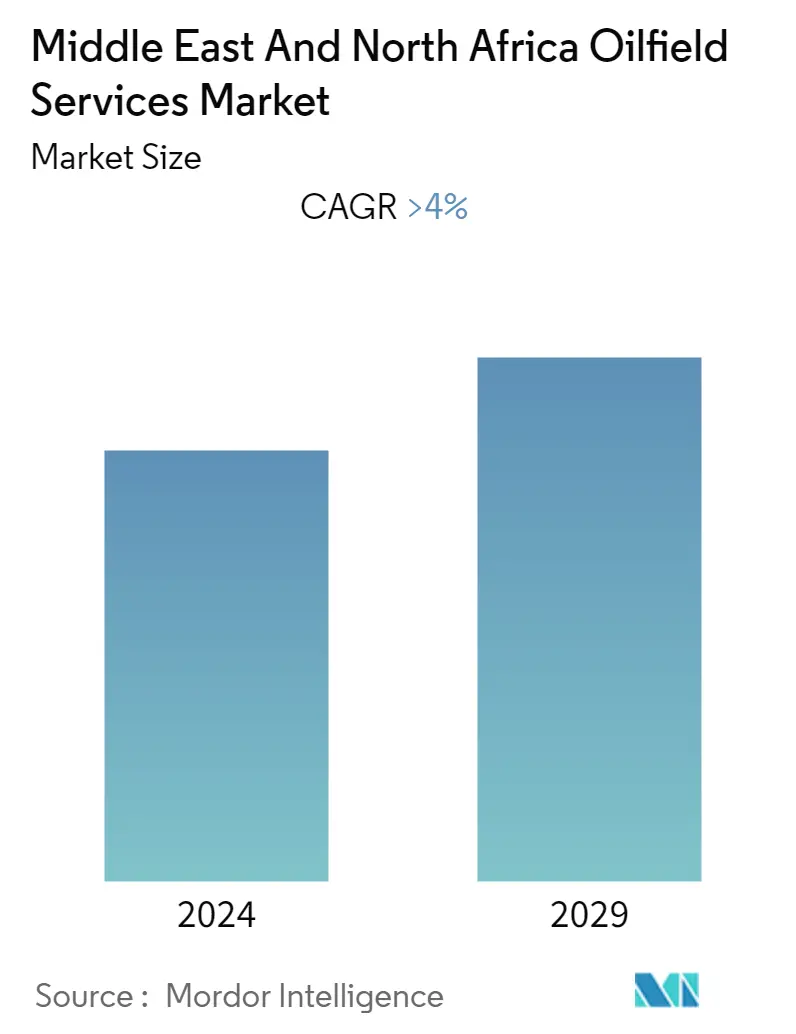
| Study Period | 2020 - 2029 |
| Base Year For Estimation | 2023 |
| Forecast Data Period | 2024 - 2029 |
| Historical Data Period | 2020 - 2022 |
| CAGR | > 4.00 % |
| Market Concentration | Medium |
Major Players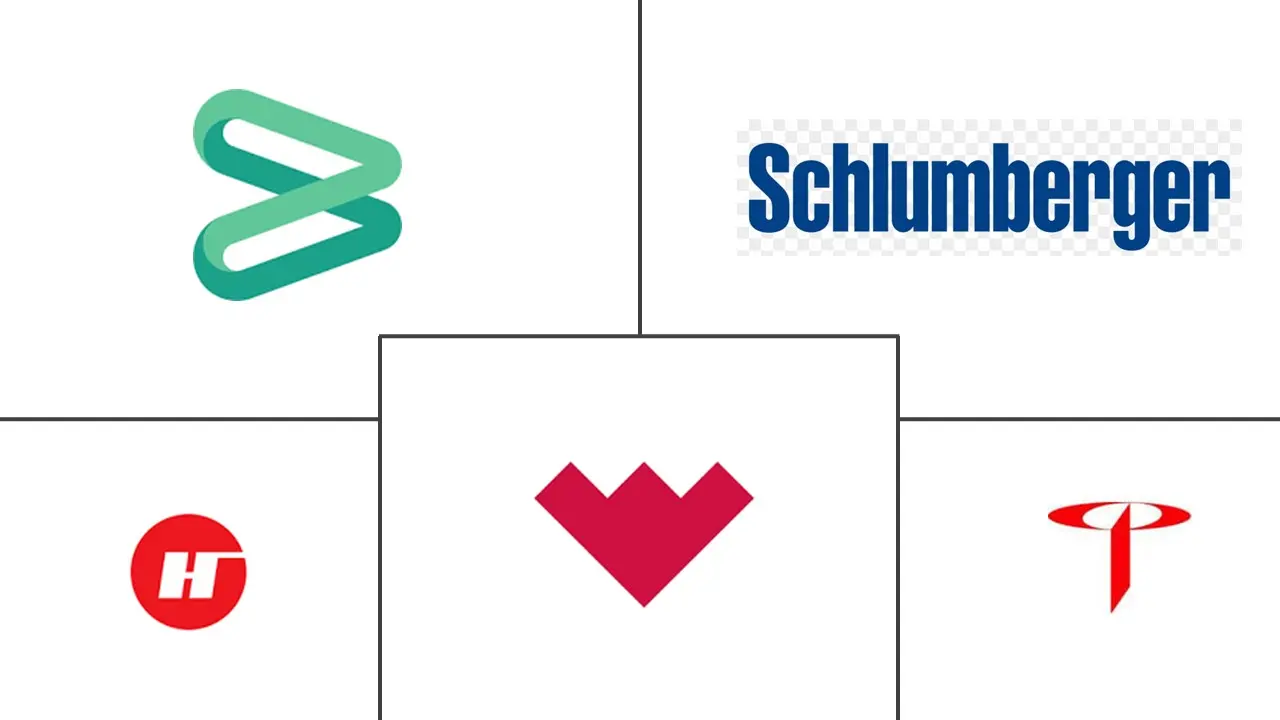
*Disclaimer: Major Players sorted in no particular order |
Middle East And North Africa Oilfield Services Market Analysis
The Middle East and North Africa Oilfield Services market is estimated to be at USD 31.69 Billion by the end of this year and is projected to reach USD 41.73 billion in the next five years, registering a CAGR of over 5.66% during the forecast period.
- In the long term, rising investments in the upstream sector aimed at increasing production capacity to maximize profits during the current high-price environment are expected to drive the market during the forecast period.
- Nevertheless, the rising adoption of renewable energy across the globe and these regions is expected to curtail the demand for hydrocarbons in the region, restraining the market during the forecast period.
- Nevertheless, the development of smaller complex offshore gas fields remains in the Mediterranean and the Red Sea remains a significant growth opportunity for the market during the forecast period.
Middle East And North Africa Oilfield Services Market Trends
Drilling Segment to dominate the market
- Drilling is one of the the most cost-intensive parts of the entire Exploration and Production (E&P) phase, and as new wells are being drilled. According to most industry estimates, drilling accounts for more than 70% of the total well costs, and hence, drilling services are expected to constitute a major part of the market revenues.
- The Middle-East and North Africa is a major global hotspot for the oil and gas upstream sector, and a signficant share of wells drilled globally are in the region. and it is estimated that nearly, during 2021, nearly 1400 wells were drilled in the region, representing nearly 2.7% of the total number of wells drilled globally during 2021.
- Similarly, according to the International Rig Count, as of September 2022, nearly 342 rigs were deployed in the Middle East and North Africa Region, accounting for nearly 38.9% of the total number of rigs deployed globally.
- Additionally, as most of the countries in the region are heavily dependent on hydrocarbon revenues to power their economies, the countries in these regions were heavily affected by the Covid-19 pandemic, as demand fell due to economic impacts of the pandemic. However, as demand hras recovered in the post-pandemic period, combined with the economic fallout of the Russia-Ukraine War, hydrocarbon prices have spiked globally. Hence, to profit from the high prices, these countries are investing heavily in expanding production capacity to rake in higher oil revenues. This is expected to result in higher investments in the E&P sector, driving the drilling segment during the forecast period.
- For instance, in the United Arab Emirates, to accelerate the expansion of production capacity, the state-owned oil and gas utility, ADNOC has been fast-tracking the development of several major projects, which primarily include some of the largest offshore fields in Abu Dhabi. ADNOC has declared that over the period of 2022-2026, it aims to invest nearly USD 127 billion on growth projects, and it is expected that over the upcoming 2 years, ADNOC is set to offer multiple engineering, procurement and construction contracts. The company has already made significant long-term investments in the sector, and the trend is expected to continue during the forecast period, driving the sector's growth and demand for oilfield and well equipment.
- For instance, in August 2022, the company offered 5 framework agreements to major oilfield services companies which include Al Ghaith Oilfield Supplies and Services Company, Al Mansoori Directional Drilling Services (Al Mansoori), Schlumberger Middle East S.A (Schlumberger), Haliburton Worldwide Limited Abu Dhabi (Haliburton) and Weatherford Bin Hamoodah Company LLC (Weatherford). These framework agreements are for directional drilling and logging while drilling (LWD) services for both onshore and offshore assets, and will run for 5 years, with an option of extending the contracts for 2 more years.
- As the Middle East and North Africa region is expected to be a major hotspot for drilling activities, the drilling segment is expected to dominate the matket during the forecast period.
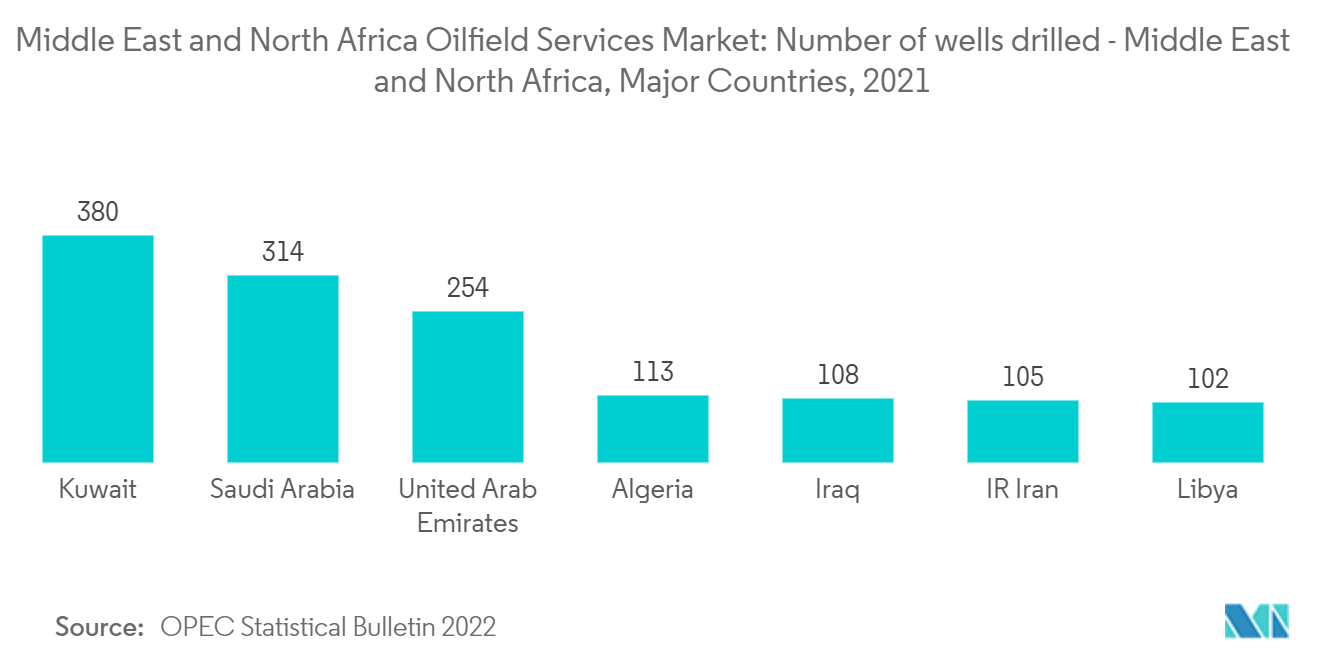
Saudi Arabia to dominate the market
- Saudi Arabia is the largest crude oil producer in the MENA region, and the country has been a global leader in upstream technology. According to the Saudi Ministry of Energy, the country produced 9124.72 thousand barrels/day of crude during 2021, making it the 3rd largest producer of crude oil, and during 2021, the country produced 120.46 billion cubic m of gas, making it the 8th largest producer globally.
- The country is the largest producer of crude oil in the MENA region and has the second largest proven crude oil reserves globally. The country's E&P sector is dominated by the state-owned hydrocarbon utility Saudi Aramco, the world's largest exporter of crude oil.
- Saudi Arabia is one of the most influential members of the OPEC cartel, and since the COVID-19 pandemic decimated energy demand globally, the country has been slowly raising production quotas to keep oil prices stable globally.
- The country's upstream sector is focused on the development on massive limestone reservoirs in the country's onshore and offshore areas such as the world's largest conventional onshore oil field (Ghawar) and the largest conventional offshore field (Safaniyah). These colossal fields have been producing for a long time, and still have significant recoverable reserves. Additionally, Saudi Arabia has also started the development of the Jafurah Shale play, the country's largest unconventional shale play, estimated to hold nearly 200 Trillion cubic feet of shale gas.
- Drilling and completion of new wells is a significant investment; however, Saudi Arabia has one of the lowest cost of drilling globally. According to Saudi Aramco, the average upstream lifting cost was SAR 11.3 (USD 3) per barrel produced in both 2021 and 2020.
- Saudi Aramco has disclosed plans to boost its capital expenditure (CAPEX) to USD 40-50 billion in 2022, up by nearly 50% from 2021, with further growth expected until 2025. The company plans to increase its crude production capacity to 13 million barrels/day by 2027 and aims to increase gas production by nearly 50% by 2030.
- Such ambitious expansion plans, coupled with new-age goals of complying with sustainability and environmental standards, is expected to attract significant investments and require major innovation in the sector, factors which are expected to drive the upstream market in the country, and the demand for oilfield services in the country during the forecast period.
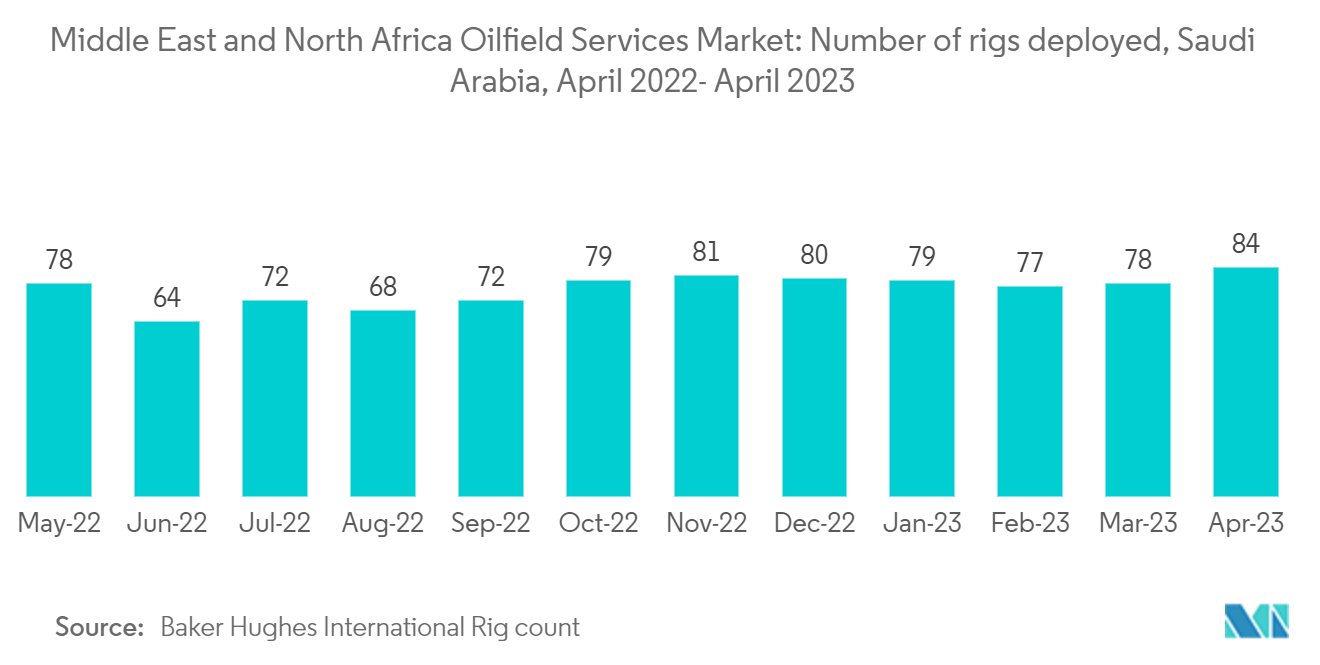
Middle East And North Africa Oilfield Services Industry Overview
The Middle East and North Africa Oilfield Services Market is moderately consolidated. Some of the major players, in no particular order, include Schlumberger Limited, Weatherford International PLC, Baker Hughes Company, Halliburton Company and Transocean Ltd., among others.
Middle East And North Africa Oilfield Services Market Leaders
-
Schlumberger Limited
-
Weatherford International PLC
-
Baker Hughes Company
-
Halliburton Company
-
Transocean Ltd.
*Disclaimer: Major Players sorted in no particular order
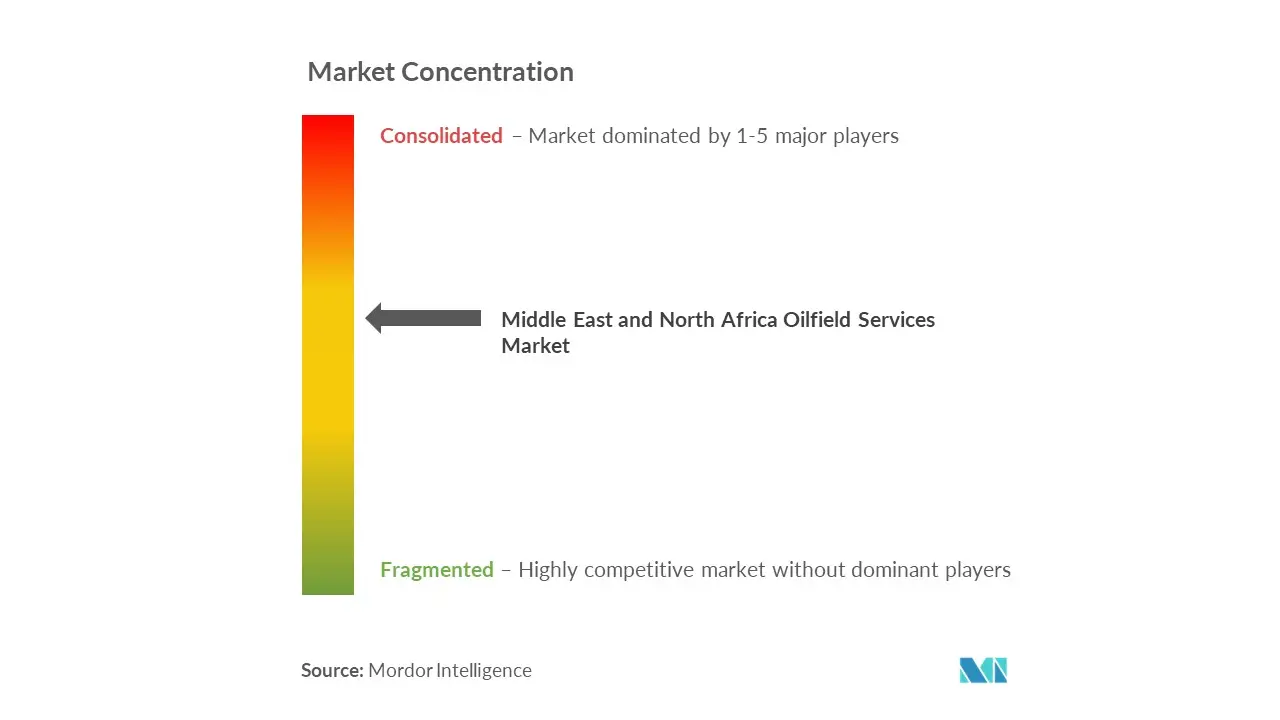
Middle East And North Africa Oilfield Services Market News
- In August 2022, ADNOC Offshore awarded a 5-year contract totaling USD 1.7 billion to ADNOC Logistics & Services (ADNOC L&S) for the hire of 13 self-propelled jack-up barges, which will be deployed across ADNOC's offshore fields. The barges will be utilized for rigless well intervention and pre- and post-drilling operations, and for topside maintenance and integrity restoration activities.
- In March 2022, Saudi Aramco awarded a major gas well drilling contract to Schlumberger. The integrated project scope consists of several drilling rigs and technologies and services, which includes drill bits, measurement while drilling (MWD) and logging while drilling (LWD), drilling fluids, cementing, and completion. Additionally, Schlumberger is under contract to provide digital solutions to enhance integrated drilling performance, including the DrillOps, an on-target well delivery solution which uses data analysis and machine learning to automate and execute a digital well plan.
Table of Contents
1. INTRODUCTION
1.1 Scope of the Study
1.2 Market Definition
1.3 Study Assumptions
2. RESEARCH METHODOLOGY
3. EXECUTIVE SUMMARY
4. MARKET OVERVIEW
4.1 Introduction
4.2 Market Size and Demand Forecast in USD billion, till 2027
4.3 Recent Trends and Developments
4.4 Recent Trends and Developments
4.5 Government Policies and Regulations
4.6 Market Dynamics
4.6.1 Drivers
4.6.2 Restraints
4.7 Supply Chain Analysis
4.8 Porter's Five Forces Analysis
4.8.1 Bargaining Power of Suppliers
4.8.2 Bargaining Power of Consumers
4.8.3 Threat of New Entrants
4.8.4 Threat of Substitutes Products and Services
4.8.5 Intensity of Competitive Rivalry
5. MARKET SEGEMENTATION
5.1 Service Type
5.1.1 Drilling
5.1.2 Completion
5.1.3 Production and Intervention
5.1.4 Other Services
5.2 By Location of Deployment
5.2.1 Onshore
5.2.2 Offshore
5.3 By Country
5.3.1 Saudi Arabia
5.3.2 United Arab Emirates
5.3.3 Iran
5.3.4 Iraq
5.3.5 Algeria
5.3.6 Others
6. COMPETITIVE LANDSCAPE
6.1 Mergers and Acquisitions, Joint Ventures, Collaborations, and Agreements
6.2 Strategies Adopted by Leading Players
6.3 Companies Profiles
6.3.1 Schlumberger Ltd
6.3.2 Halliburton Company
6.3.3 China Oilfield Services Limited
6.3.4 Baker Hughes Company
6.3.5 Weatherford International PLC
6.3.6 Transocean Ltd.
6.3.7 Valaris PLC
6.3.8 Nabors Industries, Inc.
6.3.9 Expro Group
7. MARKET OPPORTUNITIES AND FUTURE TRENDS
Middle East And North Africa Oilfield Services Industry Segmentation
Oilfield services are defined as services provided by services associated with the oil and gas exploration and production processes, i.e. the upstream sector of the energy industry. The Middle East and North Africa Oilfield Services Market is segmented by Service Type, Location of Deployment and Geography. By Service Type, the market is segmented into Drilling, Completion, Production and Intervention and Other Services. By Location of Deployment, the market is segmented in Onshore and Offshore. By Geography, the market is segmented into (Saudi Arabia, United Arab Emirates, Iran, Iraq, Egypt, Algeria and Others. For each segment, the market sizing and forecasts have been done based on revenue (USD Million).
Frequently Asked Questions
What is the current Middle East And North Africa Oilfield Services Market size?
The Middle East And North Africa Oilfield Services Market is projected to register a CAGR of greater than 4% during the forecast period (2024-2029)
Who are the key players in Middle East And North Africa Oilfield Services Market?
Schlumberger Limited, Weatherford International PLC, Baker Hughes Company, Halliburton Company and Transocean Ltd. are the major companies operating in the Middle East And North Africa Oilfield Services Market.
What years does this Middle East And North Africa Oilfield Services Market cover?
The report covers the Middle East And North Africa Oilfield Services Market historical market size for years: 2020, 2021, 2022 and 2023. The report also forecasts the Middle East And North Africa Oilfield Services Market size for years: 2024, 2025, 2026, 2027, 2028 and 2029.
Middle East And North Africa Oilfield Services Industry Report
Statistics for the 2024 Middle East And North Africa Oilfield Services market share, size and revenue growth rate, created by Mordor Intelligence™ Industry Reports. Middle East And North Africa Oilfield Services analysis includes a market forecast outlook to for 2024 to 2029 and historical overview. Get a sample of this industry analysis as a free report PDF download.



